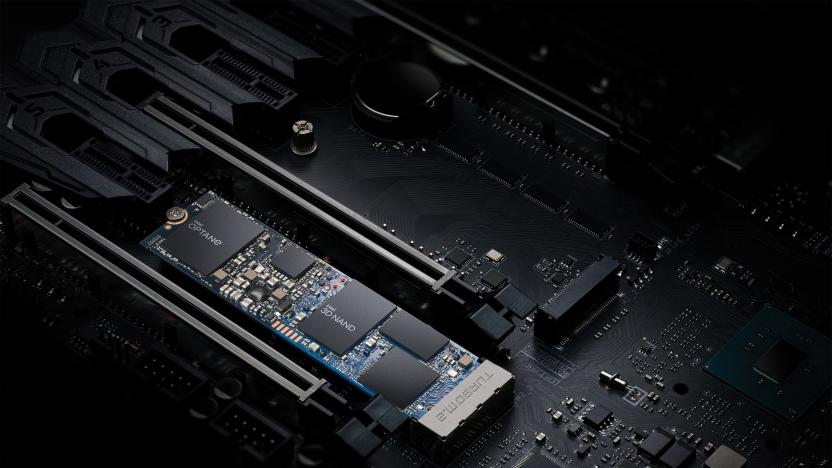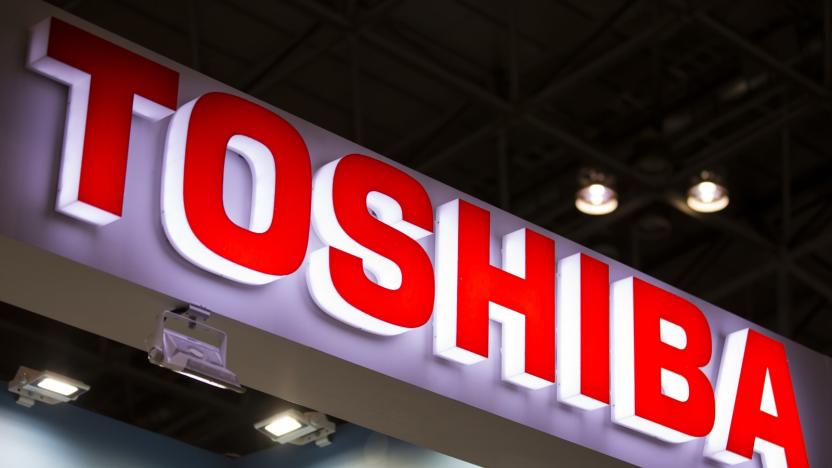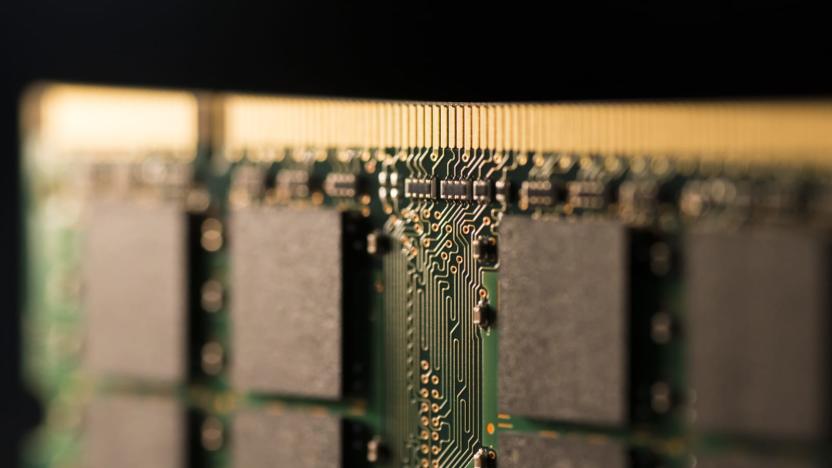nand
Latest

Intel's next-gen hybrid Optane SSDs are coming to laptops soon
Optane memory H20 is a new storage product from intel that combines its high-performance Optane memory with a regular QLC SSD in capacities of 512GB and 1TB.

Intel sells its NAND flash memory business to SK Hynix for $9 billion
Intel sold off its NAND flash memory business to South Korea's SK Hynix, but will retain control of the faster Optane technology.

Will QLC SSDs make hard drives extinct?
QLC flash is enabling bigger and bigger SSDs, including the first 8TB consumer flash drives, but it comes with the serious drawbacks. How exactly does flash memory work, what is QLC and what is it good for?

Toshiba's chip drama ends with sale to a financial group
The long-running bidding war over Toshiba's flash memory business has effectively come to an end... and the winner probably isn't who you expected. Toshiba has agreed to sell its NAND division to a group led by the private equity firm Bain Capital for the equivalent of $18 billion. This isn't going to please Western Digital, Toshiba's partner in the US, but Toshiba expects the deal to survive any legal battles. The question is why -- and whether or not Toshiba's eagerness to sell might cost you in the long run.

Toshiba's latest SSD tech squeezes 128GB onto a tinier chip
Toshiba and (we think) its partner WD have just unveiled the next generation of rapidly evolving flash memory technology. Its 96-layer NAND tech will arrive in 2018 in 3-bit, 32GB (256 gigabit) chip sizes. That will allow for SSDs and other flash products with 40 percent more storage than 64-layer NAND (which WD and Toshiba started manufacturing last month), reducing consumer prices. Furthermore, WD says that the tech is capable of 64GB all the way up to one terabit (125GB) per chip using 4-bit-per-cell technology.

Apple and Amazon want a stake in Toshiba's memory business
Apple and Amazon are joining a Foxconn bid to purchase Japanese chip giant Toshiba's NAND manufacturing division, according to Nikkei. The deal could make it easier for the companies, particularly Apple, to access all-important flash memory more cheaply for iPhones and Kindles. Foxconn has at least five other bidding rivals, including two backed by the Japanese government, which is reportedly loathe to let Toshiba's chips fall into foreign hands.

Toshiba's new flash chips hold twice the data
Judging by recent announcements, we're about to enter a golden age of fast, nearly unlimited storage for all the high-res selfies you can shoot. Following an announcement by Intel and Micron last week, Toshiba and partner SanDisk revealed their own 256Gb flash chips. Toshiba already has the smallest flash cells in the world at 15 nanometers, which it stacks in 48 layers to maximize density. The new chips add in 3-bit tech (first used by Samsung) to squeeze even more bytes in, helping it double the storage of chips it announced just a few months ago. The result will be faster and more reliable memory for smartphones, SSDs and other devices.

You'll soon get 10TB SSDs thanks to new memory tech
SSDs and other flash memory devices will soon get cheaper and larger thanks to big announcements from Toshiba and Intel. Both companies revealed new "3D NAND" memory chips that are stacked in layers to pack in more data, unlike single-plane chips currently used. Toshiba said that it's created the world's first 48-layer NAND, yielding a 16GB chip with boosted speeds and reliability. The Japanese company invented flash memory in the first place and has the smallest NAND cells in the world at 15nm. Toshiba is now giving manufacturers engineering samples, but products using the new chips won't arrive for another year or so.

Samsung unveils first SSDs with 3D V-NAND memory, but only for enterprise
Well, that was quick. Samsung said it was producing the world's first 3D vertical NAND memory just a week ago, and it has already started building the first SSDs based on that memory. Unfortunately, they're not meant for the enthusiast crowd: the new 480GB and 960GB drives are instead designed for enterprise-class servers, where V-NAND's blend of high capacity and reliability makes the most sense. Don't be too forlorn, however. Samsung promises that the new memory will eventually reach PC-oriented SSDs, which could bring spacious flash storage to a much wider audience.

Samsung ships first 3D vertical NAND flash, defies memory scaling limits
The main challenge in producing higher-capacity flash storage is one of scale -- as density goes up, so does cell interference and the chances of a breakdown. Samsung may have overcome that barrier (if temporarily) by mass-producing the first 3D vertical NAND memory, or V-NAND. Instead of putting memory cells on a conventional 2D plane, the company reworked its long-serving Charge Trap Flash technology to create a 3D cell structure with more breathing room. The result is flash that improves both reliability and speed at higher densities; Samsung claims that the new technology is 2-10X more reliable than its ancestors, and twice as quick at writing data. The initial V-NAND chip offers a 128-gigabit (16GB) capacity that we've seen before, but its underlying technique should scale quickly when a chip can include as many as 24 stacked cell layers. Although Samsung hasn't named the first devices with V-NAND inside, we won't be surprised if our next phone or SSD is particularly spacious.

Toshiba to release 4K-ready, 160MB/s CompactFlash memory cards
Toshiba will launch its Exceria Pro series of CompactFlash cards into the Japanese market tomorrow with 160MB/s read speeds and 150MB/s write speeds. The company claims the 32GB and 64GB models are the fastest CF cards you can get now, thanks to the UDMA7 protocol combined with its own NAND flash memory and custom firmware. As such, it's certified them to the "video performance guarantee profile 2" (VPG-65) standard, meaning they're guaranteed to sustain 65MB/s, which Toshiba says will support many CF-equipped 4K cameras on the market. Obviously, HD and RAW still shooters using pro DSLR models like Canon's 5D Mark III and the Nikon D800 won't have to sweat the frames-per-second, either. There's no word on US availability or pricing, but we should know more when they hit Japanese shops on April 27th.

Samsung puts 128-gigabit 3-bit cell flash into production, plans to build more memory cards
Flash memory advancements usually sing the same tune: faster, smaller and high-density. Improve one of these attributes, and you've go the makings of a better chip on your hands. Samsung is focusing on the latter, announcing the mass production of its 10 nanometer 128-gigabit three-bit multi-level-cell NAND flash. That mouthful translates into flash chips with more memory per cell in a small form factor. Sammy says the new chip is capable of 400Mbps, and claims the highest density in the industry. The new silicon will be used to expand the company's supply of 128GB memory cards and high-volume solid state drives. It's also well positioned to be a better part for devices with embedded NAND storage, which Samsung hopes will keep it competitive. You'll find Samsung's announcement and all the granular details after the break.

Patriot launches AERO wireless storage device and media hub for mobile data hogs
Patriot has just announced a new addition to its collection of storage offerings called the AERO. As the name suggests, the new device is of the wireless variety, which Patriot hopes will garner favor with owners of memory-light tablets and smartphones. To reinforce this ambition, there is of course a companion app -- Patriot Connect -- for Android and iOS that turns the device into a mobile media hub. With hooks for 3rd party media players, it hopes to overcome any format barriers, and there's also an internet pass through feature to let multiple users hit the web on the same IP. There are two capacities on offer -- 500GB and 1TB -- both with WiFi b / g / n, capacity for five connected devices, USB 3.0 and up to six hours of life on the rechargeable battery. The larger of the two will cost $199, dropping to $159 if you don't need so much storage. Both ship in early April.

Macronix plans to heat up flash memory to keep it from burning out
Despite the looming threat of being replaced by phase-change memory, contemporary memory modules aren't quite ready to be shown the door -- engineers at Macronix have found a way to revive spent NAND flash cells. Most flash modules fail after being written to and erased about 10,000 times, but Macronix found that the tired memory could be restored by baking it for extended periods of time. The team funneled the time consuming and cumbersome solution into a more practical package: a redesigned memory chip that packs onboard heaters. The new modules are designed to periodically heat focused groups of memory cells to 800 °C (1,472 °F) for a few milliseconds, effectively "healing" worn cells. Researchers found that heated chips could tolerate more than 100 million write/erase cycles and erased faster at higher temperatures. The team said the power drain of the heaters shouldn't effect battery life, either -- chips don't have to be heated often, and when they do, it can be done while prospective devices are recharging. Macronix will be presenting the technology at the IEEE International Electron Devices Meeting next week, but project deputy director Hans-Ting Lue wouldn't say when the company plans on taking the technology to market. Lue was willing to speculate on what might become of it, however. "This may evolve into a 'thermally assisted' mode of operation that gives both better performance -- such as the faster erasing -- and better endurance flash memory." Faster, more reliable, super-heated memory. Sounds fine by us. [Image credit: Emily Cooper, IEEE]

Samsung's new 10nm-process 64GB mobile flash memory chips are smaller, faster, better
Even though Samsung only announced volume production of ultra-fast eMMC memory chips back in August, it's already upgrading to a newer generation of hardware. Moving from the previous 20nm process to 10nm, the new 64GB eMMC Pro Class 2000 has a 20 percent smaller physical footprint, and claims 30 percent advantages in both performance and manufacturing productivity. While its previous chips only starting taking advantage of JEDEC's eMMC 4.5 interface standard a few months ago, Samsung plans to approach the group next year to create a new standard that can handle this design. It has a write speed of 2,000 IOPS (input/output per second) and a read speed of 5,000 IOPS, besting the 1,500/3,500 numbers reported on the older hardware, and kicks up the bandwidth to 260 MB/s read and 50MB/s write. These chips went into production late last month and are destined for slim phones and tablets near you, even if they don't say Samsung on the outside.

Intel ships SSD 335 as its first drive with 20nm flash, asks just a little to stay cutting-edge
Don't panic, SSD 330 owners: your drive hasn't been immediately rendered obsolete. Intel's new SSD 335 is just the first shipping drive using the company's 20-nanometer flash memory. The shrink down from 25nm is primarily a technological showcase that proves the more scalable, hi-K/metal gate borrowed from processors can fly in NAND-based storage. Buyers will still get the same 500MB/s read speeds and 450MB/s writes in a 2.5-inch, SATA 6Gbps drive that will stuff neatly into many desktops and laptops. Intel is shy about pricing for the lone 240GB variant on offer, although a quick scan finds it selling for a slight premium over its ancestor, at $210. While that's still frugal in this day and age, we're guessing that Intel's vow to "pass along the savings" with the SSD 335 won't truly be realized without a reseller price drop or two.

Kingmax intros UI-05 USB flash drive with glass ceiling, lets you see memory storage 'in action'
If you ever thought the world of flash storage was, well, a little pedestrian, then you've clearly never met Kingmax. The memory-maker likes to spice things up with world firsts, and exhibits an enthusiasm for the utilitarian product that can only be admired. The latest innovation? A USB drive with a glass ceiling. The UI-05, as it is known, lets you peer directly at the chip that holds your data, while keeping it waterproof and dust-proof, all in 8, 16 and 32GB denominations. Even better for you, that enthusiasm is backed up by pure faith, with the metal-cased pen drive easing nerves with a (not world first) five-year warranty. What Kingmax didn't let us see, however, was price and availability. There's a close-up shot right after the break, or you can jump to the source for more info.

Samsung creates F2FS file system for NAND flash storage, submits it to the Linux kernel
Has the lack of NAND flash storage-optimized file systems been bugging you? Then you've got something in common with Samsung, which has developed F2FS (or "Flash-Friendly File-System") for the memory of choice for mobile devices and its specific "internal geometry." It's based on a log-structured method, but tackles problems associated with older file systems intended mainly for retro, spinning-disk storage. The company isn't keeping its hard work behind lock-and-patent either -- it's gone open-source and submitted the file system to the Linux kernel, meaning you could see it implemented in Android hardware of the future. It's nice to see Sammy contributing code for the greater good, and if you've got the skills to understand it, a low-down of F2FS is available at the source below.

Samsung SSD 840 Pro caters to speed seekers with faster random access
It's difficult to thrive in the solid-state drive world. Unless you've got just the right controller and flash memory, most performance-minded PC users will rarely give you a second glance. Samsung muscled its way into that narrow view with the SSD 830 last year; it intends to lock our attention with the new SSD 840 and SSD 840 Pro. The Pro's 520MB/s and 450MB/s sequential read and write speeds are only modest bumps over the 830, but they don't tell the whole story of just how fast it gets. The upgraded MDX controller boosts the random read access to a nicely rounded 100,000IOPS, and random writes have more than doubled to 78,000IOPS or 90,000IOPS, depending on who you ask and what drive you use. The improved performance in either direction is a useful boost to on-the-ground performance, as both AnandTech and Storage Review will tell you. We're waiting on details of the ordinary triple level cell-based 840 model beyond its 120GB, 250GB and 500GB capacities, although there won't be an enormous premium for the multi-level cell 840 Pro over existing drives when it arrives in mid-October -- the flagship line should start at $100 for a basic 64GB drive, and peak at $600 for the ultimate 512GB version.

Samsung starts producing faster 2GB LPDDR3 memory for mobile devices, 128GB flash storage too
While the scales may be steadily tipping towards mobile in the world of DRAM production, there's still plenty of room for technological enhancements. To prove the point, Samsung has just started mass production of what it claims to be the first 2GB LPDDR3 DRAM chip for mobile, which can shuffle information in and out 1,600 Mbps (compared to its 1,066 Mbps LPDDR2 predecessor), with up to 12.8 GB/s of bandwidth. In addition, the manufacturer has also started mass production of a place to hold all of that lovely data, in the form of a 128GB mobile flash storage chip. When will you be able to buy a superphone sporting 2GB of RAM and 128GB of storage? We don't know for sure, but even in the face of adversity all of the components seem to be falling into place.






